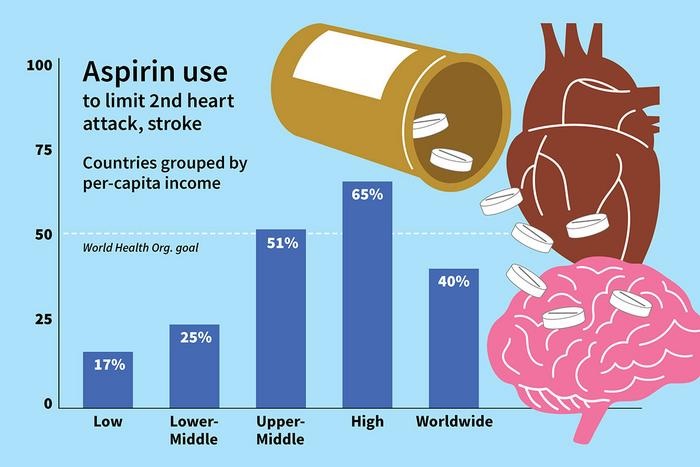Key points What is the prevalence of aspirin use among people with a history of cardiovascular disease in low-, middle-, and high-income countries? Findings Among people with a self-reported history of cardiovascular disease, aspirin use for secondary prevention was 40.3% in the pooled sample and ranged from 16.6% in low-income countries to 65.0% in low-income countries. high income. Meaning The overall findings suggest suboptimal use of aspirin for secondary prevention of cardiovascular disease in many countries around the world. |
Aspirin is widely used for its nonsteroidal anti-inflammatory and antiplatelet properties . In the prevention of atherosclerotic cardiovascular disease (CVD), aspirin is an effective, low-cost option to reduce CVD events and improve mortality among people with established CVD. The role of aspirin in the primary prevention of CVD is less clear.
Cardiovascular diseases are the leading global cause of mortality and loss of disability-adjusted life years. To ensure an effective and efficient healthcare system to prevent CVD, it is important to understand whether medication use is proportional to need. Suboptimal CVD prevention can have devastating effects on individuals, health systems, and economies. Implementation of evidence-based pharmacotherapy, including aspirin, is important to achieve the United Nations Sustainable Development Goals (SDG) Target, which aims for a one-third reduction in premature mortality from non-communicable diseases (NCDs), including CVD by 2030. There is also a need to compare progress towards the World Health Organization (WHO) key 2025 target of at least 50% of eligible people receiving aspirin for CVD prevention .
The current study aims to provide updated evidence on aspirin use worldwide among people with a history of CVD. Using nationally representative health surveys, we estimated aspirin use for secondary CVD prevention and reported its association with individual-level characteristics.
Importance
Aspirin is an effective, low-cost option for reducing atherosclerotic cardiovascular disease (CVD) events and improving mortality rates among people with established CVD. To guide efforts to mitigate the global burden of CVD, it is necessary to understand current levels of aspirin use for secondary CVD prevention.
Aim
To report and evaluate the use of aspirin for secondary prevention of cardiovascular disease in low-, middle-, and high-income countries.
Design, environment and participants
Cross-sectional analysis using pooled data from individual participants from nationally representative health surveys conducted between 2013 and 2020 in 51 low-, middle-, and high-income countries. Included surveys contained data on self-reported history of CVD and aspirin use. The sample of participants included non-pregnant adults between 40 and 69 years old.
Exhibitions
Per capita income levels of countries and regions of the world; socioeconomic demographics of individuals.
Main results and measures
Self-reported use of aspirin for secondary prevention of CVD.
Results
The overall pooled sample included 124,505 people. The median age was 52 (IQR, 45-59) years, and 50.5% (95% CI, 49.9%-51.1%) were women. A total of 10,589 people had a self-reported history of CVD (8.1% [95% CI, 7.6%-8.6%]).
Among people with a history of CVD, aspirin use for secondary prevention in the overall pooled sample was 40.3% (95% CI, 37.6%-43.0%). By income group, estimates were 16.6% (95% CI, 12.4%-21.9%) in low-income countries, 24.5% (95% CI, 20.8%-28.6%) %) in lower-middle-income countries, 51.1% (95% CI, 48.2%-54.0%) in upper-middle-income countries, and 65.0% (95% CI, 59.1% -70.4%) in high-income countries.

Figure: Worldwide, only 40% of eligible patients take daily aspirin to prevent a second heart attack or stroke, according to a new study led by Washington University School of Medicine in St. Louis. Grouped by per capita income, the data show that aspirin use is even lower in lower-income countries. The World Health Organization has set a goal for at least 50% of all eligible people to take aspirin daily by 2025.
Conclusion and relevance Worldwide, aspirin is underused in secondary prevention, particularly in low-income countries. National health policies and health systems should develop, implement, and evaluate strategies to promote aspirin therapy. |
















